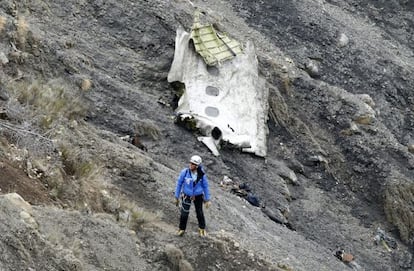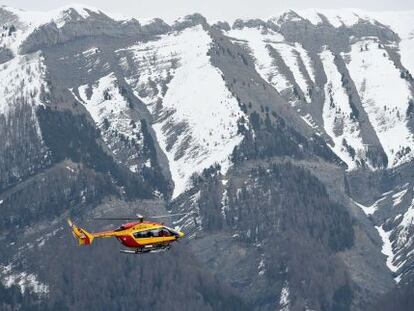Recovery and ID of bodies at crash site “will take weeks”
Inaccessible terrain impeding the task of locating human remains and wreckage


A specialized unit of mountain-trained troops march in orderly fashion along the road that borders the airfield of Seynes-les-Alpes, the site of the international operation to recover the remains of the Airbus 320 that crashed here while flying from Barcelona to Düsseldorf on Tuesday, killing all 150 people on board.
Its mission is to reach the site of the accident on foot and create a base camp. The Germanwings jet crashed in an inaccessible area of the French Alps, the Trois Évêchés massif, a towering wall of stone.
‟It’s over four hours on foot,” said sources in the Catalan government on Wednesday. But the locals in Seynes-les-Alpes think that is an understatement. ‟It’s more than seven hours,” said one resident.
The terrain is rocky, steep and off limits to anyone who is not carrying proper equipment and unfamiliar with the mountain
It is not simply a matter of time, however. The terrain is rocky, steep and off limits to anyone who is not carrying proper equipment and unfamiliar with the mountain.
“There are even small glaciers,” explains one police chief who is participating in the recovery effort.
The French Gendarmerie confirmed on Wednesday that the first human remains have been found. But the task of locating all the scattered wreckage and body parts will be very long.
“It will not be easy and it will not be quick,” warned Joana Ortega, the Catalan deputy premier.
The recovery team is made up of around 400 people, including military troops, gendarmes, forensic experts and investigators. Of these, 40 or so are on site.
The efforts begin before 8am each day, and involve flying by helicopter for five minutes to the crash site, where the aircraft cannot land because of the rugged terrain. Instead, the team members are lowered down on the ground.
The debris is scattered over a four-hectare area where the ground drops around 300 meters, said Commander Xavier Roy, in charge of coordinating the five helicopters flying over the area. With his cellphone permanently glued to his ear and a weary look on his face, Roy alternates his coordination work with answering reporters’ questions.
Roy, who is a helicopter pilot himself, has already flown over the site. ‟It’s amazing, you expect to find a large engine, a section of wing, something, but there’s nothing like that,” he says.
It’s amazing, you expect to find a large engine, a section of wing, something, but there’s nothing like that”
The largest pieces are no bigger than car parts. A day earlier, Pierre Henry Brandet, spokesman for the French Interior Ministry in the area, had asserted that part of the airplane was ‟pulverized.”
‟The odd neighbor who knows the mountain well got there on foot on Tuesday, but now it’s impossible, it’s all closed off,” said a worker at the local tourism office, where a steady stream of reporters and onlookers were filing in.
Not that there are any guides available to take people to the mountain. ‟First, because it’s very complicated, and second because they are already working with the recovery teams,” said the same sources.
The goal on Wednesday was to get a detailed picture of the crash site. Investigators took numerous photographs of the area and tried to locate the second black box, the flight data recorder. The cockpit voice recorder has already been found.
The town’s sports arena now houses a temporary support center for relatives of the victims, who are starting to arrive
Meanwhile, the town’s sports arena now houses a temporary support center for relatives of the victims, who are starting to arrive. German family members will be asked to provide DNA samples to help identify their loved ones (in Spain, the samples were taken at Barcelona airport).
But the recovery and identification work could take weeks, warned the Marseille prosecutor, Brice Robin, who is in charge of the investigation.
Fourteen judges have been assigned to the case and will deal with the removal of the bodies. Any remains will be sent to Paris or Marseille for analysis.
Tu suscripción se está usando en otro dispositivo
¿Quieres añadir otro usuario a tu suscripción?
Si continúas leyendo en este dispositivo, no se podrá leer en el otro.
FlechaTu suscripción se está usando en otro dispositivo y solo puedes acceder a EL PAÍS desde un dispositivo a la vez.
Si quieres compartir tu cuenta, cambia tu suscripción a la modalidad Premium, así podrás añadir otro usuario. Cada uno accederá con su propia cuenta de email, lo que os permitirá personalizar vuestra experiencia en EL PAÍS.
¿Tienes una suscripción de empresa? Accede aquí para contratar más cuentas.
En el caso de no saber quién está usando tu cuenta, te recomendamos cambiar tu contraseña aquí.
Si decides continuar compartiendo tu cuenta, este mensaje se mostrará en tu dispositivo y en el de la otra persona que está usando tu cuenta de forma indefinida, afectando a tu experiencia de lectura. Puedes consultar aquí los términos y condiciones de la suscripción digital.










































